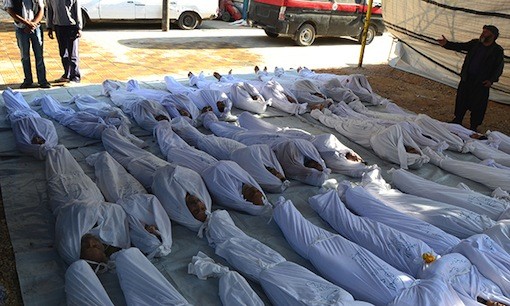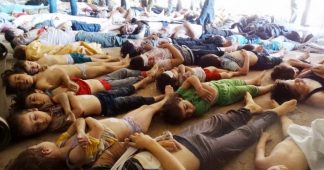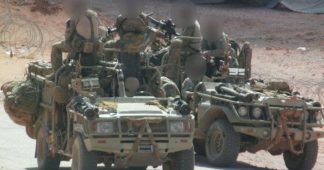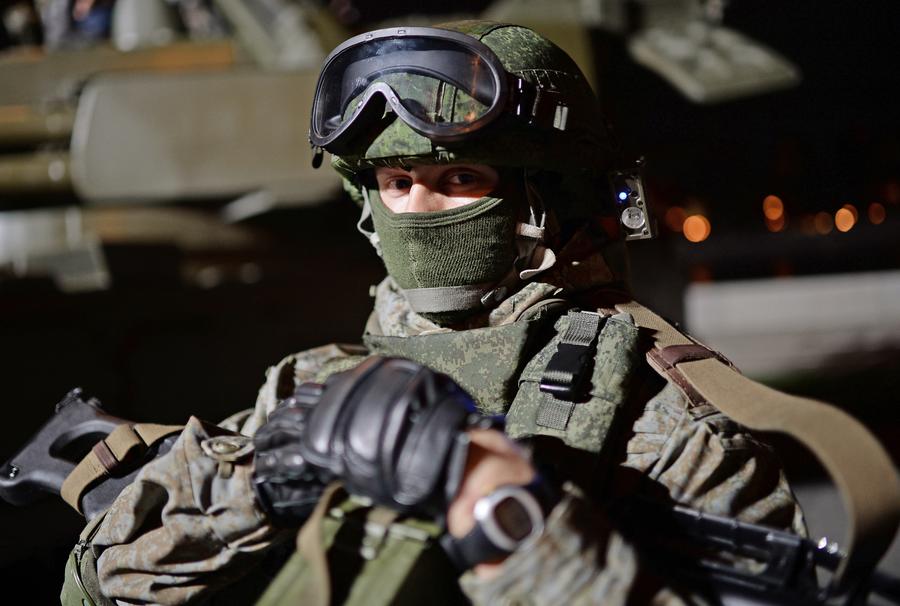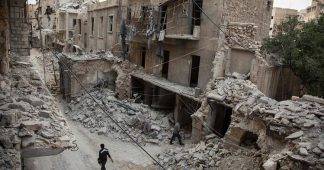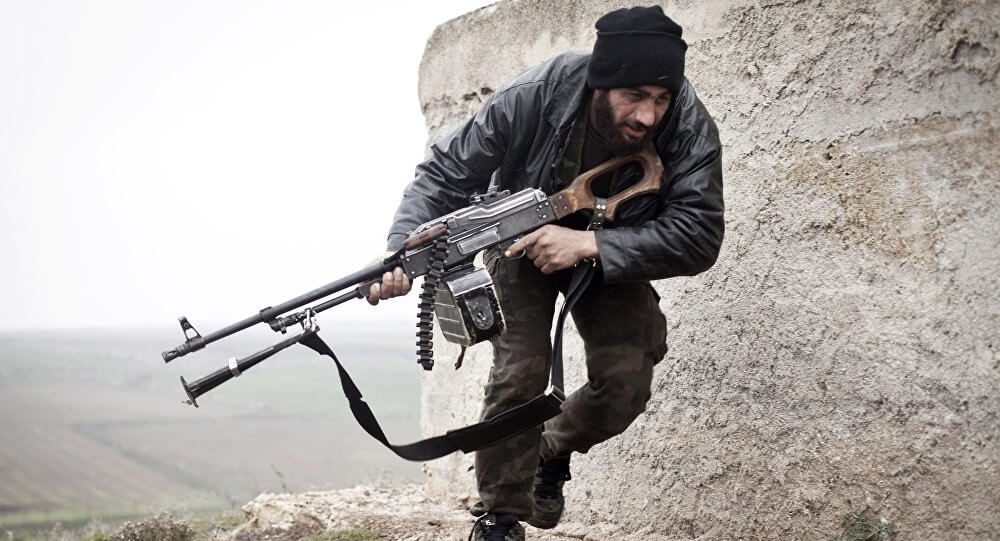Exclusive: A widely touted U.N. report accusing the Syrian government of two chlorine-gas attacks relied on shaky evidence and brushed aside witness testimony that claimed some incidents were staged, reports Robert Parry.
By Robert Parry
United Nations investigators encountered evidence that alleged chemical weapons attacks by the Syrian military were staged by jihadist rebels and their supporters, but still decided to blame the government for two incidents in which chlorine was allegedly dispersed via improvised explosives dropped by helicopters.
In both cases, the Syrian government denied that it had any aircraft in the areas at the times of the purported attacks, but the U.N. team rejected that explanation with the curious argument that Syria failed to provide flight records to corroborate the absence of any flights. Yet, if there had been no flights, there would be no flight records.
The U.N. team also dismissed out of hand the possibility that jihadist rebels who had overrun some air bases and thus had operational helicopters at their disposal might have used them as part of a staged event designed to incriminate the Damascus regime and thus justify U.S. or other outside military intervention.
Another problem with the U.N. team’s findings is that the home-made chlorine bombs had minimal military value, inflicting relatively few casualties and only a handful of deaths.
Why the Syrian government, which was under intense international pressure regarding alleged chemical weapons use and was in the process of surrendering its stockpile of such weapons, would have jerry-rigged a handful of homemade bombs and dropped them for no discernible military effect makes little sense.
However, since Syrian President Bashar al-Assad has been thoroughly demonized over his harsh reaction to an uprising that began in 2011, pretty much any accusation against him – no matter how unlikely or implausible – is widely accepted in the mainstream Western media and political circles. In other words, the U.N. team was under pressure to reach a guilty verdict.
Accusations of Staging
Yet, the evidence from at least one of the incidents examined by the U.N. team suggests that an attack on Al-Tamanah on the night of April 29-30, 2014, might well have been staged by rebels and then played up by activists through social media.
“Seven witnesses stated that frequent alerts [about an imminent chlorine weapons attack by the government] had been issued, but in fact no incidents with chemicals took place,” the U.N. report stated. “While people sought safety after the warnings, their homes were looted and rumours spread that the events were being staged. … [T]hey [these witnesses] had come forward to contest the wide-spread false media reports.
Accounts from other people, who did allege that there had been a government chemical attack on Al-Tamanah, provided suspect evidence, including data from questionable sources, according to the U.N. report.
The report said, “Three witnesses, who did not give any description of the incident on 29-30 April 2014, provided material of unknown source. One witness had second-hand knowledge of two of the five incidents in Al-Tamanah, but did not remember the exact dates. Later that witness provided a USB-stick with information of unknown origin, which was saved in separate folders according to the dates of all the five incidents mentioned by the FFM (the U.N.’s Fact-Finding Mission).
“Another witness provided the dates of all five incidents reading it from a piece of paper, but did not provide any testimony on the incident on 29-30 April 2014. The latter also provided a video titled ‘site where second barrel containing toxic chlorine gas was dropped tamanaa 30 April 14’”
Some other witnesses alleging a Syrian government attack offered curious claims about detecting the chlorine-infused “barrel bombs” based on how the device sounded in its descent.
The U.N. report said, “The eyewitness, who stated to have been on the roof, said to have heard a helicopter and the ‘very loud’ sound of a falling barrel. Some interviewees had referred to a distinct whistling sound of barrels that contain chlorine as they fall. The witness statement could not be corroborated with any further information.”
As in other cases that were investigated, the U.N. team demanded that the Syrian government provide flight records to support its denial that any of its aircraft were in the air in that vicinity at the time of the attack.
“The Government of the Syrian Arab Republic stated that no military activities were conducted from land or air in Al-Tamanah on the dates of the incidents, but did not provide any records of flight operations to support this statement,” the U.N. report said.
In the Al-Tamanah case, the U.N. team judged the evidence insufficient to reach a firm judgment regarding who was responsible. However, in two other cases, in Talmenes in April 2014 and Sarmin in March 2015, the U.N. team accused the Syrian military of dropping chlorine-infused “barrel bombs.”
Investigative Limitations
Yet, regarding all eight cases that were examined, the U.N. team acknowledged significant limitations on its ability to investigate.
The report said, “As was the case with the Fact-Finding missions, the lack of access to the locations under investigation due to the dire security situation on the ground affected the manner in which the Mechanism [a committee from the U.N. and the Organization for the Prohibition of Chemical Weapons] was able to conduct its investigation.
“Visits to certain locations would have facilitated the ability of the Mechanism to (a) confirm and access specific locations of interest; (b) collect comparative environmental samples; (c) identify new witnesses; and (d) physically evaluate the material of interest to the Mechanism (e.g., remnants).
“Other challenges and constraints include the following factors: (a) the time period that had elapsed since the incident (i.e. in some cases, more than two years since the incident); (b) the lack of chain of custody for some of the material received; (c) the source of information and material was of secondary or tertiary nature; (d) some of the information material, including those depicting the size and nature of the incident, were misleading; (e) finding independent sources of information that could provide access to individuals and information material proved difficult; and (f) the impact locations were not preserved and were compromised by the time they were recorded (e.g., the videos and photographs of the impact locations were taken days after the incident and in many cases after the remnants had been removed from the impact location).”
In other words, the U.N./OPCW investigation was compromised by its inability to conduct an effective on-the-ground assessment and was forced to rely on witnesses who were often allied with the rebel forces or sympathetic to the political opposition to President Assad.
This problem is reminiscent of what happened inside the U.S. Intelligence Community in the run-up to the U.S. invasion of Iraq when some 18 witnesses – supposedly “defectors” from Saddam Hussein’s regime – became “walk-ins” who presented claims about the Iraqi government’s supposed weapons of mass destruction.
CIA analysts debunked some of these bogus claims and traced some of the deceit to the machinations of the pro-invasion Iraqi National Congress (INC), but – given the political-and-media hatred of Saddam Hussein – the CIA analysts were under intense pressure to accept some of the dubious accounts that were then incorporated into U.S. intelligence products and used to justify a war under false pretenses.
As with Iraq – where the U.S. government had helped fund anti-regime groups such as the INC – a similar situation exists inside Syria where U.S. officials have assisted the “opposition” in organizing politically and mastering propaganda skills. So, the means and opportunity for depicting regime “atrocities” through social media are there, along with the motive.
These activists – as well as the radical jihadists and other armed rebels – have become increasingly desperate to induce the United States to intervene militarily against the Syrian army and thus make their desired “regime change” possible.
Obama’s Red Line
The emphasis on creating a chemical weapons casus belli increased when President Barack Obama set the Syrian government’s possible use of such weapons as a “red line” that might cause him to intervene directly with U.S. forces.
That comment and the political pressure for instituting another Mideast “regime change” were the backdrop for the sarin gas attack outside Damascus on Aug. 21, 2013, which anti-Assad activists, the mainstream U.S. press, and the U.S. State Department immediately blamed on government forces.
In the ensuing days, Obama came to the edge of authorizing a retaliatory military strike before hearing from U.S. and other Western intelligence services that they had doubts about who had actually pulled off the attack.
Since then, the sarin case against Assad has largely collapsed (although to defuse the crisis he agreed to a Russian plan for Syria to surrender all its chemical weapons). The evidence now appears to indicate that radical jihadists released the sarin with the goal of goading Obama into joining the war on their side, i.e., a false-flag operation.
As the sarin case fell apart in 2014, the U.S. government shifted its emphasis toward chlorine-gas allegations. I first encountered this bait-and-switch tactic when I pressed a senior State Department official to back up or back off the increasingly discredited sarin gas claims.
While sidestepping the sarin case, the official asserted that the Syrian government almost surely was responsible for the more recent chlorine-gas incidents, citing the bombs’ delivery by helicopter and arguing that only the Syrian government possessed such aircraft.
According to the U.N. report, however, that belief regarding the government’s monopoly of helicopters may not be true, since rebel forces had captured air bases where operational helicopters were present. That means, at least theoretically, the jihadists could have staged the night-time attacks – complete with prior alarms spread by activist first-responders, known as “white helmets,” about the imminent arrival of “government” helicopters with chlorine bombs.
But the more nettlesome question, which the U.N. report does not address, is why would the Syrian government launch these strange attacks while realizing that any chemical weapons incident could prompt U.S. military intervention that could tip the war in favor of the jihadists and other rebels, especially since the chlorine attacks had virtually no military value.
Few Fatalities
While the makeshift chlorine bombs may have sent scores of civilians to get medical attention, very few of the casualties were fatal, according to the U.N. report. By contrast, the Aug. 21, 2013 sarin attack killed hundreds, with the U.S. government putting out an even higher (and almost surely exaggerated) number of 1,429 dead.
In both these cases – the sarin and chlorine investigations – U.N. officials were under enormous pressure from the U.S. State Department and Western governments to come up with something that could be used to justify “regime change” in Damascus.
The U.S. State Department and various anti-Assad non-governmental organizations also had a strong motive to play up any accusations of Syrian chemical weapons use. Obama’s critics still hope to push him into an increased military intervention to remove Assad from power.
Significantly, the recent U.N. report was initially leaked to The New York Times, which has been at the forefront of agitating for another “regime change” operation in Syria. Not unexpectedly, the Times produced an article on Aug. 24 that applied no skepticism to the accusations and simply blamed the Assad government for two of the chlorine attacks.
The U.N. report wasn’t officially available until the end of August, but even then it was extremely difficult to access at the U.N.’s Web site. This week, I finally reached a U.N. press representative who walked me through the maze of links required to get to the right page, but it turned out that the page had been off-line since last Friday, the press aide said. Finally, on Tuesday, I was sent a link that worked.
Though these technical glitches may well have been coincidental, the effect was to delay any critical review of the U.N.’s report. By the time its evidentiary and logical gaps could be examined by the public, the conventional wisdom had already solidified regarding the Syrian government’s guilt.
Investigative reporter Robert Parry broke many of the Iran-Contra stories for The Associated Press and Newsweek in the 1980s. You can buy his latest book, America’s Stolen Narrative, either in print here or as an e-book (from Amazon andbarnesandnoble.com).
